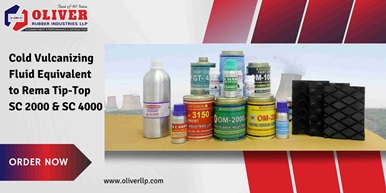At Oliver Rubber LLP, we take pride in being one of the foremost manufacturers of high-quality rubber sheets in India. With our commitment to excellence and innovation, we have established ourselves as a trusted name in the industry. Our extensive range of rubber sheets caters to diverse applications across various sectors, including automotive, construction, industrial, and more. Among our standout products is the Rubber Pulley Lagging Sheet, a critical component designed to improve the performance and longevity of conveyor systems. At Oliver Rubber LLP, we understand that every customer has unique requirements. That’s why we offer customizable solutions to tailor our rubber sheets according to your specific dimensions, thickness, hardness, and other parameters. In this blog, we’ll dive deep into the world of Pulley Lagging, exploring its purpose, types, installation methods, and more.
What is a Lagging Pulley?
A lagging pulley refers to a pulley in a conveyor system that has been coated or covered with a material—typically rubber—to enhance its functionality. The Rubber Pulley Lagging Sheet serves as this protective and performance-enhancing layer. Its primary purpose is to increase friction between the pulley and the conveyor belt, preventing slippage, reducing wear, and extending the lifespan of both the pulley and the belt. By improving traction, pulley lagging ensures smoother operations, especially in wet or dusty environments where slippage is a common issue.
What Thickness is a Pulley Lagging?
The thickness of Pulley Lagging varies depending on the application and operational demands. At Oliver Rubber LLP, we offer Rubber Pulley Lagging Sheets in a range of thicknesses, typically between 6mm to 20mm, though custom options are available. For light-duty conveyors, a thinner lagging (6-10mm) may suffice, while heavy-duty industrial applications, such as mining or bulk material handling, often require thicker lagging (12-20mm) for added durability and protection. The right thickness ensures optimal performance without adding unnecessary weight to the system.
How to Install Lagging on a Pulley?
Installing Pulley Lagging is a straightforward process when done with the right tools and materials. Here’s a basic guide:
- Preparation: Clean the pulley surface thoroughly to remove dirt, rust, or grease.
- Measurement and Cutting: Measure the pulley’s dimensions and cut the Rubber Pulley Lagging Sheet to fit precisely.
- Adhesive Application: Apply a high-quality adhesive (more on glue-on lagging later) to both the pulley and the lagging sheet.
- Attachment: Press the lagging sheet onto the pulley, ensuring no air bubbles form. Use a roller for even adhesion.
- Curing: Allow the adhesive to cure as per the manufacturer’s instructions, typically 24 hours.
- Trimming: Trim any excess material for a clean finish.
For weld-on options, professional assistance may be required, which we’ll cover later.
Pulley Lagging in Conveyor Belt
In conveyor belt systems, Pulley Lagging plays a vital role in maintaining efficiency. It prevents belt slippage, reduces downtime, and protects the pulley from abrasive materials. The Rubber Pulley Lagging Sheet from Oliver Rubber LLP is engineered to withstand harsh conditions, making it ideal for industries like mining, cement production, and agriculture, where conveyor belts are subjected to heavy loads and constant use.
Types of Pulley Lagging
There are several types of Pulley Lagging to suit different needs:
- Plain Rubber Lagging: Smooth surface for general-purpose use.
- Diamond Groove Lagging: Features a diamond pattern for superior grip in wet conditions.
- Ceramic Lagging: Embedded with ceramic tiles for extreme durability and traction.
- Herringbone Lagging: A grooved design that channels water away, reducing slippage.
At Oliver Rubber LLP, we specialize in customizable Rubber Pulley Lagging Sheets to match your specific requirements.
Pulley Lagging Material
The material used for Pulley Lagging significantly impacts its performance. Our Rubber Pulley Lagging Sheets are made from premium-grade rubber compounds, offering excellent abrasion resistance, flexibility, and durability. Other materials, like ceramic or polyurethane, are also used in specific applications, but rubber remains the most versatile and cost-effective choice for most industries.
Pulley Lagging Cost
The cost of Pulley Lagging depends on factors like material, thickness, size, and customization. A standard Rubber Pulley Lagging Sheet from Oliver Rubber LLP is competitively priced, offering exceptional value for its quality and longevity. While ceramic lagging may cost more upfront, rubber lagging provides a budget-friendly solution without compromising performance. Contact us for a tailored quote based on your needs.
Glue on Pulley Lagging
Glue-on Pulley Lagging is one of the most popular installation methods due to its simplicity and effectiveness. Using a strong adhesive, the Rubber Pulley Lagging Sheet is bonded directly to the pulley surface. This method is ideal for smaller pulleys or systems where welding isn’t feasible. At Oliver Rubber LLP, we recommend high-quality adhesives to ensure a secure, long-lasting bond.
Conveyor Pulley Lagging
Conveyor Pulley Lagging is essential for optimizing conveyor system performance. Whether it’s a drive pulley, tail pulley, or take-up pulley, lagging enhances traction and protects against wear. Our Rubber Pulley Lagging Sheets are designed to handle the toughest conditions, ensuring your conveyor system runs smoothly and efficiently.
Weld-on Pulley Lagging
For heavy-duty applications, weld-on Pulley Lagging offers a robust alternative. This method involves attaching metal-backed rubber strips to the pulley using welding techniques. While more complex than glue-on lagging, it provides unmatched durability for high-impact environments. Oliver Rubber LLP offers weld-on compatible Rubber Pulley Lagging Sheets for industries requiring extra strength.
Conveyor Lagging
Conveyor Lagging encompasses all lagging applied to conveyor pulleys, regardless of the method or material. At Oliver Rubber LLP, we provide comprehensive solutions, from Rubber Pulley Lagging Sheets to expert guidance on installation and maintenance. Our products ensure your conveyor system operates at peak performance, minimizing downtime and maximizing productivity.
Why Choose Oliver Rubber LLP?
When it comes to Pulley Lagging, Oliver Rubber LLP stands out for our dedication to quality and customization. Our Rubber Pulley Lagging Sheets are crafted with precision, using advanced manufacturing techniques to meet the diverse needs of our clients. Whether you’re in construction, automotive, or heavy industry, we have the expertise and products to support your operations. With a focus on innovation and customer satisfaction, we’re proud to be a leading name in India’s rubber sheet industry.
For more information or to request a custom solution, reach out to Oliver Rubber LLP today. Let us help you enhance your conveyor systems with the best Rubber Pulley Lagging Sheets on the market!



